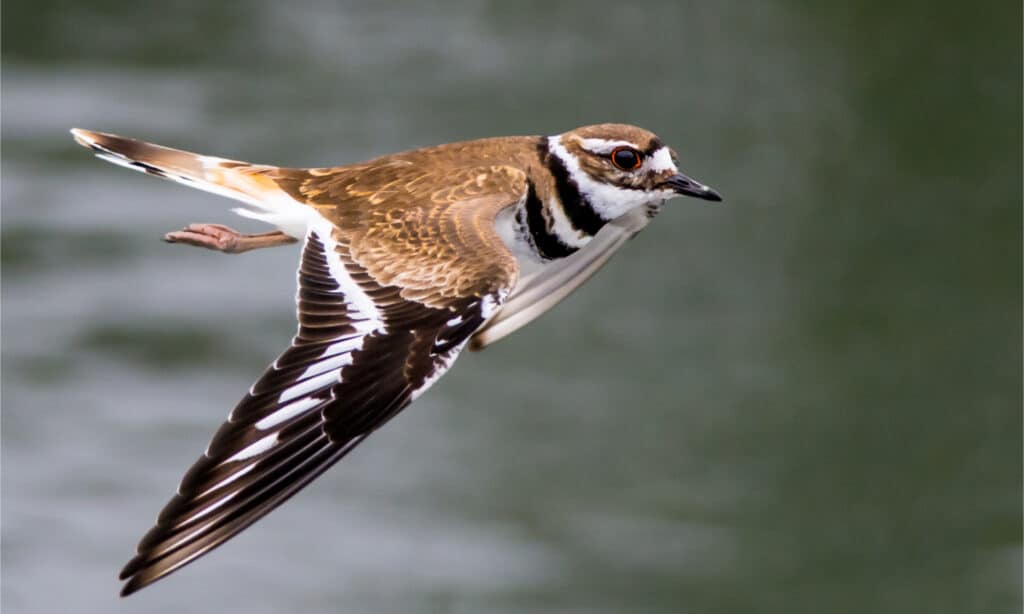Killdeer
Charadrius vociferus
The killdeer feigns injury to draw a predator away from its nest.
Advertisement
Killdeer Scientific Classification
- Kingdom
- Animalia
- Phylum
- Chordata
- Class
- Aves
- Order
- Charadriiformes
- Family
- Charadriidae
- Genus
- Charadrius
- Scientific Name
- Charadrius vociferus
Read our Complete Guide to Classification of Animals.
Killdeer Conservation Status
Killdeer Facts
- Prey
- Insects, spiders, worms, snails, crayfish, centipedes, and seeds
- Fun Fact
- The killdeer feigns injury to draw a predator away from its nest.
- Estimated Population Size
- Up to 2.3 million mature individuals
- Biggest Threat
- Pesticide use and accidents
- Most Distinctive Feature
- The black markings around the neck and breast
- Other Name(s)
- Chattering plover and noisy plover
- Wingspan
- 18 - 19 inches
- Incubation Period
- 24-28 days
- Type
- Bird
- Common Name
- Killdeer
- Number Of Species
- 1
- Nesting Location
- On the ground
- Age of Molting
- 25 days
- Migratory
- 1
View all of the Killdeer images!
In order to communicate, the killdeer makes a shrill “kill-deer” sound for which it’s named.
The killdeer is a member of the plover group. These are small wading birds that congregate near large bodies of water to feed and mate. Although they may look rather plain, their behavior is incredibly complex and interesting to observe. They are very common throughout most of their North American range.
3 Killdeer Amazing Facts
- As a plover, the killdeer is a surprisingly effective swimmer. Almost from the time the baby killdeers are born, they can navigate both fast and slow-moving water with ease.
- In order to fly, the killdeer make stiff, occasional beats with their sharp, angular wings.
- Among all species of plovers, the killdeer is the least likely to be found near water.
Where to Find the Killdeer
Even though it sometimes lives near a body of water, the killdeer can be found mostly inland on open ground with sparse vegetation. Fields, sandbars, mudflats, lawns, driveways, parking lots, and even roofs of buildings are some of their most common habitats. Their natural range extends throughout North America and South America. Some of the countries in which they’re found include:
Killdeer Nests
The killdeer usually constructs its nest on open terrain where it has a good view of oncoming predators. Bare soil, gravel roads, or grass fields may all be chosen as a potential site. The nest is just a shallow depression in the ground lined with grass, twigs, pebbles, and other debris. Materials may be continuously added throughout the year.
Scientific Name
The scientific name of the killdeer is Charadrius vociferus. Vociferus means shout or yell in Latin; it’s where we get the word vociferous. This species is closely related to the piping plover, snowy plover, and Eurasian dotterel within the same genus of Charadrius.
Size, Appearance, and Behavior
The killdeer is a fairly small bird, measuring anywhere between 8 and 11 inches from head to tail. They are characterized by a slender body, round head, large eyes, pointed tail, and short narrow bill. The color scheme is brown or tan on top and white along the stomach, neck, and forehead. This is accompanied by a few black bands encircling the neck, forehead, and breast. It also has a bright orange rump, most evident in flight. The female may have more brown plumage around the breast and face, but juveniles look mostly the same as adults.
Killdeers usually live alone or in small breeding pairs, but they do gather in very loose flocks outside of the breeding season. In order to communicate, they make several loud, piercing sound, including the kill-dee or kill-deer call for which they’re known. This call serves as a kind of alert system for species of all types in their immediate area. It is often accompanied by excited and frantic alarm behavior.
Migration Pattern and Timing
The killdeer tends to reside in temperate climates for the summer; their range almost reaches as far as northern Canada. Starting around August or September, the killdeer migrates south. The southern United States is a preferred destination, but some may travel as far away as Central America and South America. They return early in the spring, sometimes by February or March. However, some populations may be permanent residents of the southern United States and northern Mexico all year-round and do not migrate.

Killdeer wings are 18 – 19 inches long, sharp, and angular.
©JoshCW Photo/Shutterstock.com
Diet
The killdeer hunts very carefully along the ground by taking a few steps, stopping, and then pecking the soil in search of food. It will also sometimes follow farmers as they plow their fields and turn up the soil.
What does the killdeer eat?
The diet of the killdeer largely consists of insects such as grasshoppers, beetles, and caterpillars. They also consume spiders, worms, snails, crayfish, centipedes, and seeds.
Predators, Threats, and Conservation Status
According to the IUCN Red List, the killdeer is a species of least concern. They are fairly adaptable to habitat loss and human-modified habitats. However, their proximity to humans also makes them vulnerable to pesticide poisoning, collisions, and other accidents. Population numbers appear to be in decline.
What eats the killdeer?
Both adults and chicks are preyed upon by numerous animals, including foxes, coyotes, raccoons, skunks, snakes, domestic cats, crows, ravens, gulls, and birds of prey. In order to protect its nest, the killdeer will lure a predator away with a broken wing display. In other words, it will feign injury to trick the predator.
Reproduction, Young, and Molting
When the breeding season arrives, usually as early as the spring, the killdeer will attempt to attract a new mate. Both sexes put on prominent displays of flight in which they make their loud killdeer sounds. They also engage in a ritual known as the scrape ceremony. The male lowers his body and scrapes out a shallow depression in the ground with his feet. If the female is interested, she will approach the depression and take his place. The male then responds by spreading his body and calling excitedly.
After mating, the female may produce anywhere between three and five eggs at a time. Both parents take turn incubating the eggs. In order to keep the eggs cool, the parents will provide shade with their wings and even soak their belly feathers in water. After about 24 to 28 days, the baby chicks will hatch with a soft down of feathers. They are watched over by their parents but mostly have the ability to leave the nest and search to feed themselves. The chicks will start to fly after about 25 days. A killdeer pair can produce two or three broods per year, but most are only responsible for one. Sexual maturity is achieved after only a single year. They have a maximum known lifespan of 11 years in the wild, but many fall victim to predation and disease long before that time.
Population
Based on various estimates, the total breeding population may be anywhere between a million and 2.3 million. Their numbers declined around 26 percent between 1966 and 2019, but they are still very common and widespread. Killdeer are currently protected from persecution by the US Migratory Bird Act in the United States.
View all 77 animals that start with KKilldeer FAQs (Frequently Asked Questions)
Does the killdeer migrate?
Yes, the killdeer migrates south every year for the winter.
How many eggs does the killdeer lay?
A single female lays a clutch of three to five eggs at a time.
How fast does the killdeer fly?
The top speed is thought to be around 35 miles per hour.
What is the killdeer’s wingspan?
The killdeer has a wingspan of 18 to 19 inches long.
When do killdeers leave the nest?
The baby chicks start to venture from the nest almost immediately after hatching, but they may not leave the nest permanently until after about 25 days.
Why do they call it a killdeer?
They are named after the call they make.
Are killdeer good pets?
As a wild animal, killdeer do not generally make good pets. It may be illegal to own them in many places throughout the world.
Are killdeer birds rare?
No, they are quite common throughout their natural range.
Can a killdeer kill a deer?
No, the name has nothing to do with deer at all.
What is the lifespan of a killdeer?
The lifespan is thought to be around 11 years in the wild.
Thank you for reading! Have some feedback for us? Contact the AZ Animals editorial team.
Sources
- All About Birds, Available here: https://www.allaboutbirds.org/guide/Killdeer/overview
- Audubon, Available here: https://www.audubon.org/field-guide/bird/killdeer
- Animal Diversity, Available here: https://animaldiversity.org/accounts/Charadrius_vociferus/

















